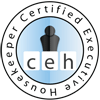The decision to engage in green cleaning often begins with product selection. Green cleaning involves the use of detergents and other products containing few or no ingredients harmful to building occupants or to the environment.
By law, all cleaning products sold in the U.S. and Canada must be labeled with appropriate cautions and warnings about any acutely hazardous, poisonous or toxic ingredients. These instructions are the first place to look for clues as to whether a product might be “green” or not. However, also by law, manufacturers do not need to list chemistries that are proprietary or chemicals that are not among the "active" cleaning ingredients. Many of these hidden substances may be hazardous to your health over time or in combination with other chemicals in the environment.
If you want to employ green cleaning in your home, use the following guidelines when evaluating product labels:
- Avoid products with bold warnings that include words such as “poison” or “toxic.”
- When choosing a sanitizer or disinfectant, choose the mildest product ingredients possible (for example, hydrogen peroxide instead of chlorine bleach). The label will include such information.
- Look for biodegradable products. Their components will decompose into harmless minerals, carbon dioxide and water.
- Choose products whose packaging may be recycled in your area.
- Avoid products with ingredients such as certain volatile organic compounds (VOCs), EDTA (a chelating agent in detergents), or more than a minimal amount of phosphates (above 0.5 percent). These substances either contribute to air pollution, aren’t biodegradable or have a number of undesirable effects in environmental water.
When shopping, keep in mind that labels may (or may not) mention biodegradability or the inclusion of undesirable compounds. One way to be sure is to check with the manufacturer. Many product labels include a toll-free telephone number for “questions and comments,” and some makers’ Web sites include comprehensive product information. You may also check the Household Products Database, sponsored by the National Institutes of Health, for known hazards and warnings on specific brand names.
Reference:
Arthur Weissman, Ph.D., is president and chief executive officer of Green Seal, a non-profit green cleaning certification organization. For more information, see Dr. Weissman’s Housekeeping Channel articles, “How to Choose a Green Cleaning Product” and “Weighing Green Products.”









